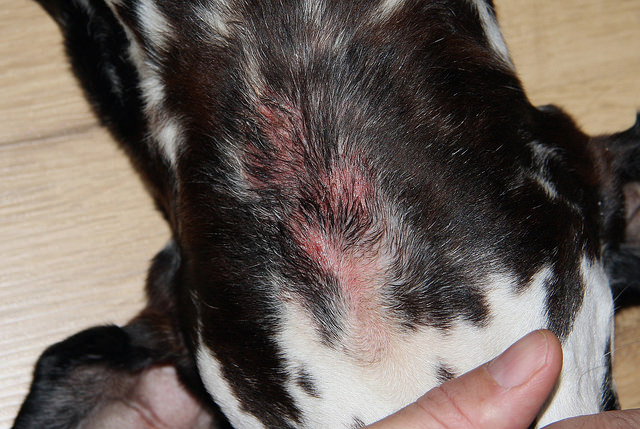It is the time of year when I start to see lots of skin issues. One of those is Pyotraumatic Dermatitis or Hot Spot. A hot spot is an area of the skin that is inflamed and excoriated. The hair is often missing in the center and all the hair around the lesion is caked together with moist, smelly crusts. It is extremely uncomfortable for the dog and smelling the odor is not pleasant for you.

Why do hot spots happen?
Pyotraumatic dermatitis is just what the name describes: “pyo” meaning pus, “traumatic” meaning the dog has scratched or rubbed the area and “dermatitis”, inflammation of the skin. Most people just call them “Hot Spots” and boy, are they hot! I tell clients that I think they feel like the carpet burns we used to get on our knees as kids, only worse because they are inflamed and infected. Anything that can cause your dog to scratch or rub an area until it is inflamed (like a flea bite), can lead to a hot spot. Once the surface is raw, infection can set in and then all the drainage and moisture associated with the infection sets up a vicious cycle that your dog cannot break.
Who gets them?
I see certain breeds more commonly for hot spots and a study in 2004 did too. The researchers saw Rottweilers, German Shepherds and Golden Retrievers most often in their study.¹ I think that this breed specific representation might be because of the characteristics of the hair coats on these dogs as well as concurrent allergic disease, but any dog can get a hot spot.

How are they treated?
When I treat a hot spot, my primary goal is to get air to the infection and kill as many of the bacteria as I can. Because of the level of pain, this frequently involves sedating the dog, soaking away the crusts and clipping the hair. Then we scrub the area with strong (but safe) anti-infective scrub and send the patient home with antibiotics, topical preparations, pain medications and an E-collar. If you catch a hot spot before it becomes infected (when it is still just a red area of hair loss), sometimes you can manage it at home without the sedative. Clip the hair away to get air to the area and apply an e-collar to keep your dog from further traumatizing the area. Clean away debris gently with a damp cloth. If your dog is awake, it is probably best to avoid any kind of soap.
When do you need to call your vet about a hot spot?
If the spot has a foul odor, there is a good chance you will need antibiotics to help get control. Only a vet can prescribe antibiotics and he/she will have to examine your dog first. Even if there is no foul odor, but your dog really fights you when you try to cleanse the area, it is probably kindest to let your vet anesthetize for treatment. If you are able to try to manage at home and there is no improvement in a day or so, go ahead and give the vet a call.
Hot Spots are no fun for either of you. To prevent them, eliminate possible causes (like fleas) by making sure your dog is on an effective flea control program overseen by a veterinarian. Sometimes you will not know what the inciting cause was, but your vet might.
- Vet Dermatol. 2004 Dec;15(6):369-76.A prospective study of the clinical findings, treatment and histopathology of 44 cases of pyotraumatic dermatitis. Holm BR, Rest JR, Seewald W.
